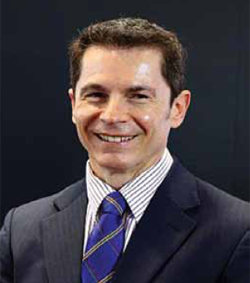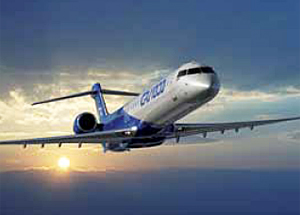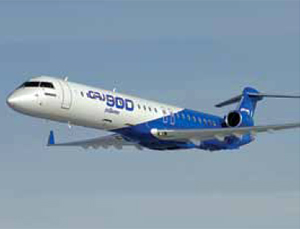- Prime Minister Narendra Modi inaugurates Aero India 2023 in Bengaluru; Releases Commemorative Stamp
- Defence Secretary meets delegations from Saudi Arabia, USA and Oman on the sidelines of Aero India 2023
- Foreign Ministers of 32 countries to attend Aero India 2023
- Embraer showcases the C-390 Millennium at Aero India 2023
Bombardier Fleet steadily climbing in Asia

Bombardier is the world’s largest manufacturer of both planes and trains. Bombardier is evolving mobility worldwide by answering the call for more efficient, sustainable and enjoyable transportation everywhere. Here in an interview with Jayant Baranwal, Editor-in-Chief, the Vice President Sales, South East Asia and Australasia, Frank Baistrocchi gives details about Bombardier’s plans in India.
Jayant Baranwal (Baranwal): Which one according to Bombardier Commercial sells fast and sells the most – turboprop or jet?
Frank Baistrocchi (Baistrocchi): Bombardier has built a leading portfolio of commercial aircraft in the 60- to 150-seat category. More than 1,200 Q Series turboprops have been ordered and the program includes approximately 150 owners and operators worldwide. Our most advanced model – the Q400 aircraft – counts over 60 owners and operators in almost 40 countries worldwide. Bombardier has recorded firm orders for a total of 547 Q400 aircraft.
The CRJ Series regional jet family includes over 100 owners and operators in approximately 40 countries. Bombardier has booked firm orders for a total of 1,883 CRJ Series aircraft. We have booked 678 orders and commitments for our all-new C Series aircraft – including firm orders for 243.
We have forecasted that the 60- to 100-seat segment will continue to be one of the most dynamic in commercial aviation over the next 20 years. It is anticipated that the fleet in this segment will more than double in size. Deliveries will be split roughly equally between regional jets and turboprops, with lower forecasted fuel prices favouring the regional jet share.
The 100- to 150-seat segment, which has not been the focus of aircraft development for at least the past two decades, will witness a major fleet transformation with the entry-into-service of new clean-sheet aircraft designs.
Baranwal: What are the contemporary features of Q series and CRJ series?
Baistrocchi:
Q400 AIRCRAFT
Designed as a modern, 21st-century turboprop, the Q400 aircraft is the most recent development in the Q Series family of aircraft. It provides unmatched performance, operational flexibility and passenger comfort. Thanks to its combination of turboprop attributes, jet-like features, industry-leading passenger experience and light environmental footprint, the Q400 aircraft is exceptionally versatile and can be adapted to a variety of business models.
The Q400 is an aircraft nimble enough for a steep approach, yet tough enough to land on unpaved runways. It’s a real performer at high altitudes airports too, like that of La Paz, Bolivia, one of the world’s highest. By offering an additional 12 to 14 seats, 20 per cent cash operating cost advantage per seat, and over 30 per cent higher speed, the Q400 turboprop delivers over $8 million US additional value per aircraft compared to competing turboprops. Its speed – 160 kmph faster than conventional turboprops – puts the aircraft’s flight time within minutes of jet schedules, at the same seat-cost as larger single-aisle jets.
CRJ SERIES AIRCRAFT
The CRJ Series regional jets have revolutionised aviation with their proven efficiency, reliability and profitability. The CRJ Series regional jets share commonality benefits that provide flexibility to operators and allow them to optimise their fleets to meet specific market demands. No other regional aircraft deliver this capability. Optimised for medium-haul regional routes, these aircraft can provide up to 10 per cent cash operating cost advantage over competing jets.
Each of the CRJ aircraft models offers its own distinct advantages. The CRJ200 regional jet offers outstanding ownership cost, ideal for opening new routes and markets. The CRJ700 regional jet is the lightest aircraft in its category, delivering impressive efficiency, performance and fuel burn savings, while the CRJ900 regional jet offers tremendous flexibility and is ideally suited for growing markets. The CRJ1000 regional jet, which has the highest passenger capacity in the family, delivers the lowest seat-mile cost in the regional jet market and burns up to 13 per cent less fuel than its competitors.

Baranwal: What kind of presence Bombardier Commercial has enjoyed in Asia?
Baistrocchi: The fleet of Bombardier commercial aircraft in the Asia-Pacific region is steadily growing with more than 360 Q Series turboprops, CRJ regional jets and C Series airliners now in service with, or on firm order from, approximately 50 customers and operators in the region. Sales and Marketing Offices are located in Singapore, and Shanghai, China.
Bombardier Commercial Aircraft’s Customer Services network includes: Regional Support Offices in Singapore; Shanghai, China; Tokyo, Japan; and Mumbai, India; Parts Services Depots in Singapore; Tokyo, Japan; and Hong Kong and Beijing, China; Authorized Service Facilities include STAECO in Jinan, China and GMR Aero in Hyderabad, India.
Baranwal: Could you give us some details on the Bombardier Commercial’s presence in India?
Baistrocchi: India represents a great market opportunity for Bombardier Commercial Aircraft. Our fleet includes up to 19 Q Series turboprops and CRJ regional jets. As part of Bombardier Commercial Aircraft’s globalisation strategy, the demand for the Q Series, CRJ Series and the C Series in India presents a significant opportunity to grow the company’s presence and market share in this region and we have numerous sales campaigns on-going.
Additionally, Bombardier Commercial Aircraft’s presence in India has grown over the years and we are working to further expand it in the very near future. We currently have a regional support office in Mumbai (since 2010) and an authorised service facility in Hyderabad (GMR Aero Technic, 2015).
Baranwal: What is the current deployment of Bombardier Commercial aircraft in India and what do you see the figure to be in the next five to 10 years?
Baistrocchi: India represents a great market opportunity for Bombardier Commercial aircraft. Our fleet in India includes up to 19 Q Series turboprops and CRJ regional jets. As part of Bombardier Commercial Aircraft’s globalisation strategy, the demand for Q Series, CRJ Series and C Series aircraft in South Asia presents a significant opportunity to grow the company’s presence and market share in this region.
Bombardier Commercial Aircraft’s market forecast for the period 2015-2034, covering aircraft from 60to150 seats, predicts deliveries of 700 units to the South Asia region (which includes India) over the forecast period. Over the next 20 years, we forecast that the industry will deliver 300 aircraft in the 60- to 100-seat category in South Asia.
Over the next 20 years, we forecast that the industry will deliver 400 aircraft in the 100- to 150-seat category in South Asia. Bombardier’s portfolio of commercial aircraft – the Q400 turboprop, the CRJ Series regional jets and the all-new C Series family of aircraft – are ideally suited to meet the forecasted requirement for 700 aircraft in the 60- to 150-seat category in the South Asia region.
Baranwal: What will be the factors driving the growth of the regional aviation market, according to you?
Baistrocchi: Commercial airlines are profitable and growing. The industry continues to evolve to manage growth, volatile fuel prices and increasing competition. Most new 60- to 150-seat aircraft deliveries to mature aviation markets will replace retiring aircraft fleets.
In emerging markets, demand for air travel is growing with increasing GDP and an expanding middle class. Lower oil prices may permit airlines to delay the replacement or retirement of less efficient aircraft types, but in the long-term, fuel efficiency will remain a key driver of airline fleet decisions.
Economic and technological obsolescence, as well as environmental regulations are expected to drive aircraft retirements over the next 20 years.
The government has been laying emphasis on regional connectivity, how does Bombardier factor into the government’s plan?
India is witnessing substantial growth, and predominant growth is expected from cities and industrial towns which remain underserved. Ouraircraft platforms can accommodate the development of new regional route networks to connect inaccessible and under-served communities — bringing together people, economic growth and development.
Baranwal: Which unique qualities and features of your aircraft be it Q Series or CRJ Series, you will be pitching in the Indian market which is likely to grow substantially?
Baistrocchi: The unique qualities and features for the Indian market are the same as highlighted in the question above:
Q400 AIRCRAFT
- Unmatched performance, operational flexibility and passenger comfort.
- Industry-leading passenger experience.
- Adaptability to a variety of business models.
- Excellent performer at high altitudes airports and in diverse hot, humid environments.
- 20 per cent cash operating cost advantage per seat, and over 30 per cent higher speed compared to competitive turboprops.
- Delivers over $8 million US additional value per aircraft compared to competing turboprops.
- 160 kmph faster than conventional turboprops – puts the aircraft’s flight time within minutes of jet schedules, at the same seat-cost as larger, single-aisle jets.
CRJ SERIES AIRCRAFT

- Proven efficiency, reliability and profitability.
- Provides flexibility to operators and allows them to optimise their fleets to meet specific market demands.
- The CRJ200 provides outstanding ownership cost; it’s ideal for opening new routes and markets.
- The CRJ700is the lightest aircraft in its category, delivering impressive efficiency, performance and fuel burn savings.
- The CRJ900 delivers tremendous flexibility and is ideally suited for growing markets.
- The CRJ1000 offers the highest passenger capacity in the family, delivers the lowest seatmile cost in the regional jet market and burns up to 13 per cent less fuel than its competitors.
C SERIES AIRCRAFT
- 100 per cent all-new design that offers operators up to $13 million extra value per aircraft.
- Unparalleled economic advantage to operators and new opportunities for single-aisle aircraft operations.
- Deliver a greater-than 10 per cent unit cost advantage compared to similarly-sized, reengined aircraft.
- Best-in-class economics.
- Superior passenger experience – the aircraft offers 19-inch-wide seats that set a new industry standard, large overhead bins that accommodate a carry-on bag for each passenger, and the largest windows in the singleaisle market.
- It is the quietest in-production commercial jet in its class. The aircraft’s noise performance and its outstanding short-field capability make it ideal for varied types of operations.
The short haul market has competition from rail and road, do you think Bombardier range of aircraft can compete in such a situation?
Yes, our aircraft are designed to serve the short-medium haul markets and to compete effectively against other forms of transportation.
Look at SpiceJet for example: as India’s preferred low-fare airline, they focus on establishing their foothold in, and catering to these markets which require an aircraft that could increase the reach to over 60 airports that could not be served by larger jets. After evaluating aircraft options in the 60- to 100-seat category, they selected Q400 turboprops, which combines excellent reliability, economics and passenger comfort.
Baranwal: Can you elaborate on the environment initiatives of Bombardier Commercial?
Baistrocchi: Here are some initiatives:
CO2 EMISSIONS:
The Q400 turboprop burns 30 per cent less fuel and produces 30 per cent lower emissions on short-haul routes where it has replaced jet aircraft of similar capacity — that’s over 4,000 tonnes lower emissions each year per aircraft. The CRJ Series aircraft’s lightweight and highly efficient aerodynamics provide the best fuel burn and lowest greenhouse gas emissions in its class. he C Series aircraft’s fuel burn advantage translates directly into a 20 per cent reduction in CO2 emissions. This means that one C Series aircraft could reduce an operator’s CO2 emissions by up to 6,000 tonnes each year.
NOISE:
All noise performance testing on the CS100 aircraft has been completed and data confirms it is the quietest in-production commercial jet in its class. The aircraft’s noise performance and its outstanding short-field capability make it ideal for varied types of operations. Noise reduction isn’t just responsible, it’s profitable. This will lead to a balance between increased airport utilisation and community quality of life.
The Q400 turboprop is one of the quietest aircraft flying today, inside and out. This makes the Q400 a very attractive aircraft for operation at city centre airports such as London and Toronto and other noise sensitive airports.
LIFE CYCLE APPROACH
We have adopted a life cycle approach to ensure that Bombardier aircraft are conceived, designed, built, used and disposed of with the least possible effects on the environment. 100 per cent of our manufacturing and service sites with over 150 employees are certified to ISO 14001 environmental standards.
(Concluded)





